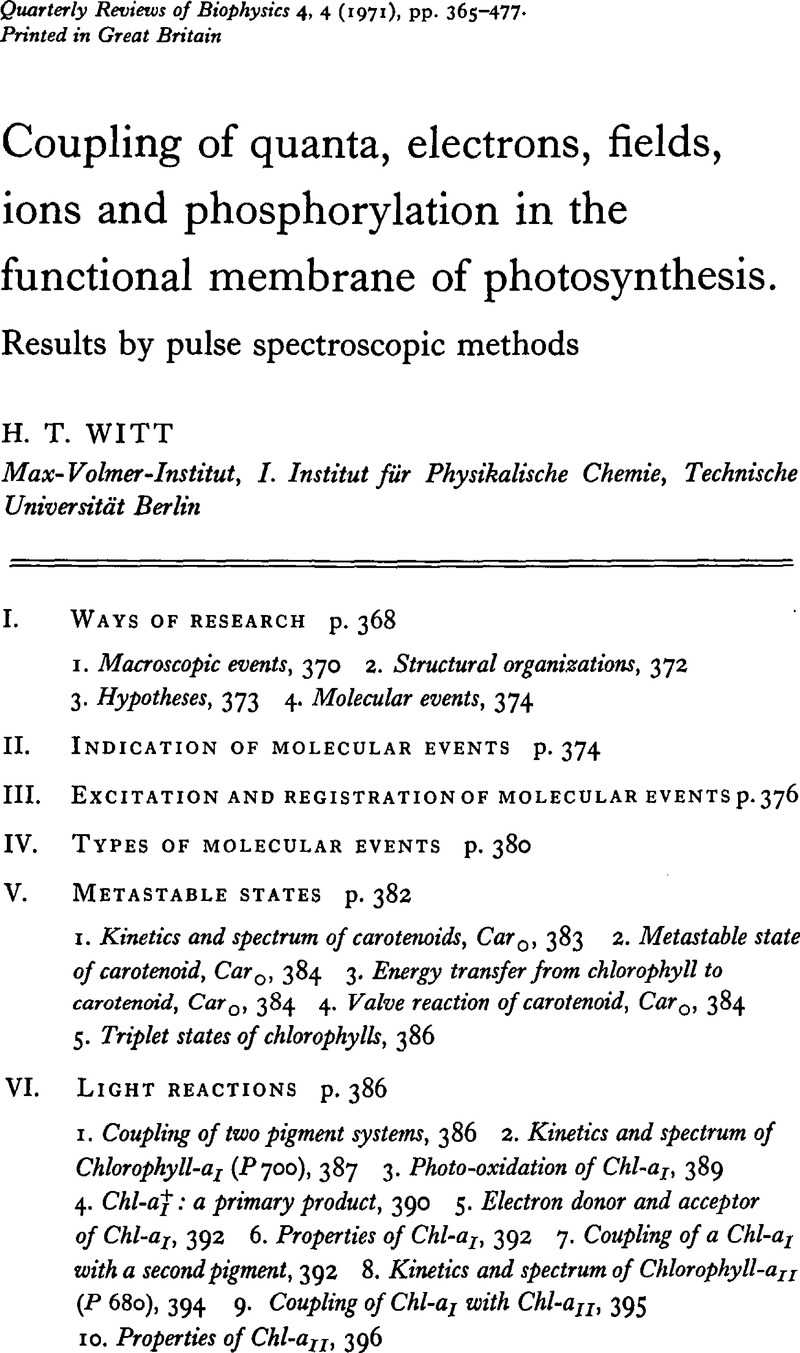Crossref Citations
This article has been cited by the following publications. This list is generated based on data provided by Crossref.
Boeck, M.
and
Witt, H. T.
1972.
Photosynthesis, two centuries after its discovery by Joseph Priestley.
p.
903.
HONG, FELIX T.
and
MAUZERALL, DAVID
1972.
Photoemf at a Single Membrane-Solution Interface specific to Lipid Bilayers containing Magnesium Porphyrins.
Nature New Biology,
Vol. 240,
Issue. 100,
p.
154.
Witt, H. T.
1972.
Energy transduction in the functional membrane of photosynthesis results by pulse spectroscopic methods.
Journal of Bioenergetics,
Vol. 3,
Issue. 1-2,
p.
47.
Witt, H. T.
1972.
Membrane Structure and Mechanisms of Biological Energy Transduction.
p.
47.
1973.
Electrical evidence for the field indicating absorption change in bioenergetic membranes.
FEBS Letters,
Vol. 37,
Issue. 2,
p.
307.
Gould, J.Michael
and
Ort, Donald R.
1973.
Studies on the energy coupling sites of photophosphorylation. III. The different effects of methylamine and ADP plus phosphate on electron transport through coupling sites I and II in isolated chloroplasts.
Biochimica et Biophysica Acta (BBA) - Bioenergetics,
Vol. 325,
Issue. 1,
p.
157.
Haehnel, Wolfgang
1973.
Electron transport between plastoquinone and chlorophyll aI in chloroplasts.
Biochimica et Biophysica Acta (BBA) - Bioenergetics,
Vol. 305,
Issue. 3,
p.
618.
Amesz, J.
1973.
Fortschritte der Botanik.
p.
89.
Renger, Gernot
1973.
Die Primärprozesse der Photosynthese.
Angewandte Chemie,
Vol. 85,
Issue. 11,
p.
515.
Radmer, Richard
and
Kok, Bessel
1973.
A kinetic analysis of the oxidizing and reducing sides of the O2-evolving system of photosynthesis.
Biochimica et Biophysica Acta (BBA) - Bioenergetics,
Vol. 314,
Issue. 1,
p.
28.
Vredenberg, W.J.
Homann, P.H.
and
Tonk, W.J.M.
1973.
Light-induced potential changes across the chloroplast enclosing membranes as expressions of primary events at the thylakoid membrane.
Biochimica et Biophysica Acta (BBA) - Bioenergetics,
Vol. 314,
Issue. 2,
p.
261.
Renger, Gernot
1973.
The Primary Processes of Photosynthesis.
Angewandte Chemie International Edition in English,
Vol. 12,
Issue. 6,
p.
510.
Hind, Geoffrey
and
McCarty, Richard E.
1973.
Photophysiology.
p.
113.
Vater, Joachim
1973.
On the nature of the deactivator of the water-splitting system in photosynthesis.
Biochimica et Biophysica Acta (BBA) - Bioenergetics,
Vol. 325,
Issue. 1,
p.
149.
Horwitz, B.A.
and
Horwitz, L.P.
1973.
Electronic distribution coding in cellular differentiation.
Journal of Theoretical Biology,
Vol. 42,
Issue. 1,
p.
169.
Giaquinta, R.T.
Dilley, R.A.
and
Anderson, B.J.
1973.
Light potentiation of photosynthetic oxygen evolution inhibition by water soluble chemical modifiers.
Biochemical and Biophysical Research Communications,
Vol. 52,
Issue. 4,
p.
1410.
Bensasson, R.
and
Land, E.J.
1973.
Optical and kinetic properties of semireduced plastoquinone and ubiquinone: Electron acceptors in photosynthesis.
Biochimica et Biophysica Acta (BBA) - Bioenergetics,
Vol. 325,
Issue. 1,
p.
175.
Renger, G.
1973.
The action of 3-(3,4-dichlorophenyl)-1,1-dimethylurea on the water-splitting enzyme system Y of photosynthesis.
Biochimica et Biophysica Acta (BBA) - Bioenergetics,
Vol. 314,
Issue. 1,
p.
113.
Lavorel, J.
1973.
Kinetics of luminescence in the 10−6–10−4-s range in Chlorella.
Biochimica et Biophysica Acta (BBA) - Bioenergetics,
Vol. 325,
Issue. 2,
p.
213.
Gould, J. Michael
and
Izawa, Seikichi
1973.
Photosystem‐II Electron Transport and Phosphorylation with Dibromothymoquinone as the Electron Acceptor.
European Journal of Biochemistry,
Vol. 37,
Issue. 1,
p.
185.





